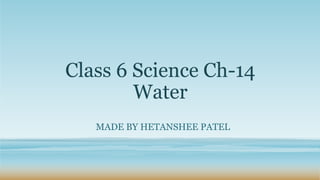Class 6 science ch 14 water
•Transferir como PPTX, PDF•
7 gostaram•7,589 visualizações
Please find the attached ppt of Class 6 Ch-14 Water
Denunciar
Compartilhar
Denunciar
Compartilhar

Recomendados
Recomendados
Mais conteúdo relacionado
Mais procurados
Mais procurados (20)
Chapter - 10, Respiration in Organisms, Science, Class 7

Chapter - 10, Respiration in Organisms, Science, Class 7
Class 6 chapter 4 Sorting materials into groups ppt 3

Class 6 chapter 4 Sorting materials into groups ppt 3
Semelhante a Class 6 science ch 14 water
Semelhante a Class 6 science ch 14 water (20)
33 part 1-earthsoft-water - critical resource-basic

33 part 1-earthsoft-water - critical resource-basic
Último
Último (20)
Seismic Method Estimate velocity from seismic data.pptx

Seismic Method Estimate velocity from seismic data.pptx
Pulmonary drug delivery system M.pharm -2nd sem P'ceutics

Pulmonary drug delivery system M.pharm -2nd sem P'ceutics
9999266834 Call Girls In Noida Sector 22 (Delhi) Call Girl Service

9999266834 Call Girls In Noida Sector 22 (Delhi) Call Girl Service
Forensic Biology & Its biological significance.pdf

Forensic Biology & Its biological significance.pdf
Asymmetry in the atmosphere of the ultra-hot Jupiter WASP-76 b

Asymmetry in the atmosphere of the ultra-hot Jupiter WASP-76 b
Formation of low mass protostars and their circumstellar disks

Formation of low mass protostars and their circumstellar disks
dkNET Webinar "Texera: A Scalable Cloud Computing Platform for Sharing Data a...

dkNET Webinar "Texera: A Scalable Cloud Computing Platform for Sharing Data a...
Introduction,importance and scope of horticulture.pptx

Introduction,importance and scope of horticulture.pptx
Locating and isolating a gene, FISH, GISH, Chromosome walking and jumping, te...

Locating and isolating a gene, FISH, GISH, Chromosome walking and jumping, te...
Vip profile Call Girls In Lonavala 9748763073 For Genuine Sex Service At Just...

Vip profile Call Girls In Lonavala 9748763073 For Genuine Sex Service At Just...
Class 6 science ch 14 water
- 1. Class 6 Science Ch-14 Water MADE BY HETANSHEE PATEL
- 2. Topics to be covered today are :- 1. What is water ? 2. Uses of Water 3. Why there is shortage of water ? 4. Importance of water in one’s lives 5. States of water 6. Sources of water 7. Water Cycle
- 3. Introduction • About three fourth of the Earth’s surface is covered with water. • It is made up of tiny molecules of Hydrogen and Oxygen. It is precisely made up of 2 Hydrogen atoms (H2) and 1 Oxygen atom (O). • Therefore, its chemical value is H2O. • Pure drinking water has no smell, no taste and no color.
- 6. Why there is shortage of Water ? i. 97.4 of the available water is in seas and oceans which cannot be directly used by us because of its high salt content. A lot of freshwater is in form of glaciers and in the polar ice caps. Thus, only 0.01% of the water on the Earth is available to us for consumption . ii. There is also shortage of water because of increasing population in country. iii. This can also happen because of floods at some places and droughts for years at some places.
- 7. Importance of Water • Water is essential for life . A person can live without food for several weeks, but without water, life cannot last for more than few days. • Water makes it importance such as digestion of food, absorption of nutrients by the body, distribution of nutrients to various parts of the body in humans and animals takes place only in the presence of water. • About 70% of human body consists of water. • Plants use water, along with carbon-dioxide from the air, to make food in presence of sunlight.
- 9. Sources of Water • There are many sources of water some of them are :-
- 18. Water Cycle •The water cycle is the journey of water in which it circulates from the land to the sky and back again.
- 19. Water Cycle
- 20. What are 4 stages of Water Cycle ? • The four stages of Water Cycle are :- • Evaporation • Condensation • Precipitation • Collection
- 21. Evaporation • Evaporation is when the sun heats up water in river or lakes or the oceans and turns it into vapour or steam. Water is the form of steam leaves the river, lake or ocean and goes in the air.
- 22. Condensation • Water vapour in air gets cold and changes back into liquid, forming clouds. This is called Condensation.
- 23. Precipitation • Precipitation occurs when so much water has condensed that the air cannot hold it anymore. The clouds get heavy and water falls back to the Earth in the form of rain, hail, sleet or snow.
- 24. Collection • When water falls back to the Earth by precipitation, it may fall back in the oceans, lakes or rivers or it may end up on land. When it end up on land it will either soak in the Earth and become part in the “Groundwater” that plants and animals used to drink or it may run over the soil and collect in the oceans, lakes or rivers where the cycle starts.